Roller shutter slat roll forming machines are used to produce the curved metal slat profiles needed for roller shutter doors and windows. This guide provides detailed information on slat roll former types, workings, specifications, applications, selection, operation, maintenance, and comparisons.
Introduction to Roller Shutter Slat Roll Forming Machines
Roller shutter slat roll forming machines cold form metal coils into the curved profiles used as horizontal louvers in roller shutters and rolling doors. Key features:
- High production speeds up to 40 meters/minute
- Capability to produce different slat shapes and sizes
- Quick and easy size changeover
- Compact and flexible setup
- Consistent quality and close tolerances
- Low operational costs
Roll formed slats are efficient for high volume roller shutter production versus manual methods.
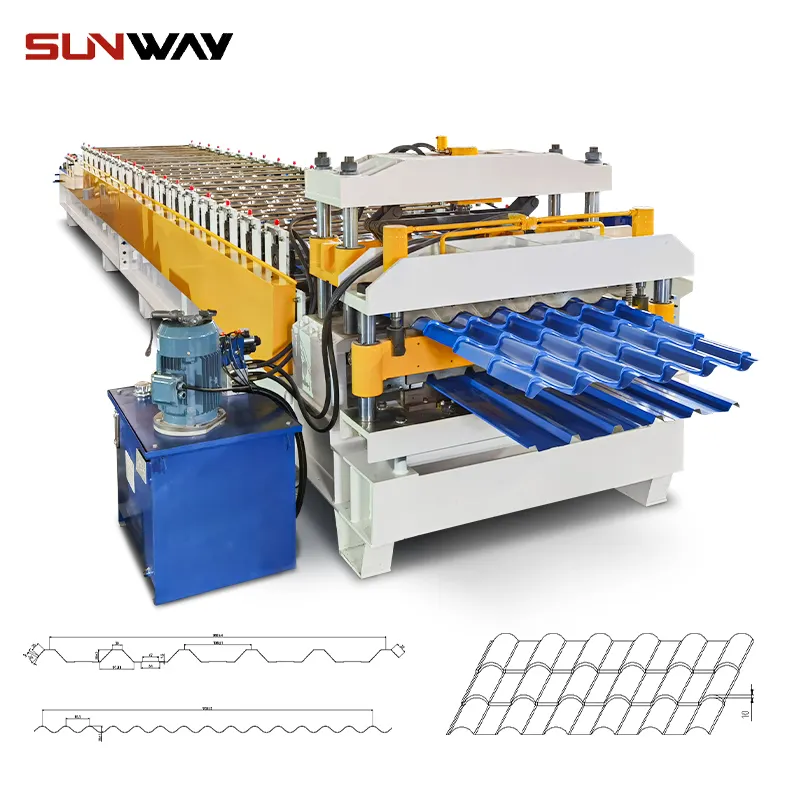
Types of Roller Shutter Slat Roll Forming Machines
Major Types of Slat Roll Forming Machines
- C Shape Slat Roll Former
- Double C Shape Slat Roll Former
- Insulated Slat Roll Former
- Automatic Cutting Slat Roll Former
- Manual Slat Roll Former
- Custom Slat Roll Former
Dedicated machines produce specific slat profiles. Flexible universal roll formers can be switched between multiple shapes and sizes.
Working Principle of Roller Shutter Slat Roll Forming Machines
Slat Roll Forming Process Steps:
- Coil feeding into the roll former
- Sheet passed through progressive roller stations
- Formed into curved slat profile gradually
- Cutting to required length by built-in shear
- Formed slats discharged for collection
It continuously forms metal coils into curved shutter slat profiles.
Key Specifications of Roller Shutter Slat Roll Formers
Technical Specifications:
- Production Speed: 10 – 40 meters/minute
- Forming Width: 80 – 180 mm
- Material Thickness: 0.4 – 1 mm
- Main Drive Power: 1.5 – 4 kW
- Voltage: 220 – 440 V, 3 phase
- Machine Length: 4000 – 8000 mm
- Machine Weight: 1500 – 3000 kg
- Number of Stations: 8 – 16
Specifications depend on required output, material type, and slat dimensions.
Design and Components
Machine Design:
- Robust welded steel frame construction
- Coil holding uncoiler and feeding unit
- Initial sheet guiding system
- Roller stations for bending into slat profile
- Hydraulic shearing system
- Formed slat discharge system
- Electrical controls with automation
Main Components:
- Coil loading and feeding section
- Roll forming stations with guides
- Shearing unit for cutting
- Outfeeding tables for slats
- PLC based controller
- Safety guarding system
Sturdy construction and quality components ensure reliable high-speed production.
工作原理
Sequence of Slat Roll Forming:
- Coil loaded and fed into the machine
- Sheet pre-bent and passed through progressive stations
- Formed into curved slat profile gradually
- Hydraulic shear cuts slats to length
- Formed slats slide down outfeed tables
- HMI touchscreen automates production
- Sensors monitor operation and halt machine on faults
The cold roll forming action transforms flat metal coil into curved shutter slats.
Raw Material Suitability
Suitable Coil Materials:
- Hot rolled steel
- Cold rolled galvanized steel
- Stainless steel coils
- Aluminum coils
Key Material Parameters:
- Thickness – 0.4 to 1 mm
- Width – 700 to 1250 mm
- Tensile Strength – 280 to 550 MPa
- Coil Weight – Up to 5 tons
Properly specified coils avoid cracking or warping issues.
定制选项
Customization of Slat Roll Lines:
- Profile dimensions and tolerances
- Quick changeover between sizes
- Special coatings like colors, prints, powder coat
- Hole punching and embossing
- Safety enclosures and lighting
- Integration with upstream/downstream processes
- Touchscreen HMI and data logging
Modular components enable reconfiguration for different profiles, metals and special features.
-
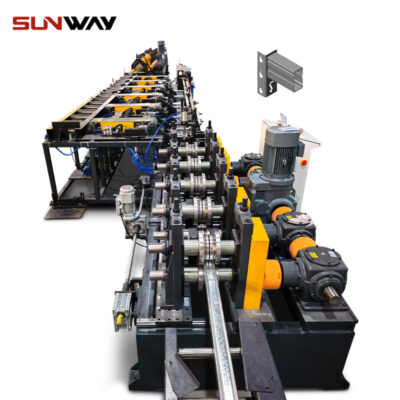 Storage Rack Shelf Box Panel Making Machine Steel Storage Rack System Box Beam Roll Forming Line
Storage Rack Shelf Box Panel Making Machine Steel Storage Rack System Box Beam Roll Forming Line -
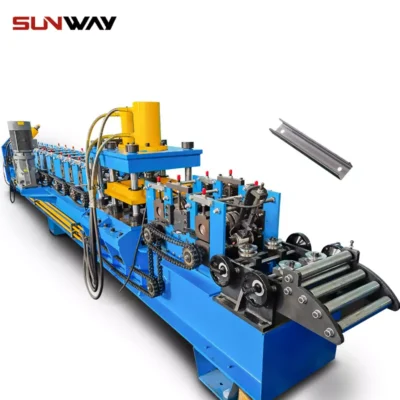 सी सेक्शन ब्रेसिंग ओमेगा स्टोरेज रैक अपराइट पोस्ट रोल बनाने की मशीन
सी सेक्शन ब्रेसिंग ओमेगा स्टोरेज रैक अपराइट पोस्ट रोल बनाने की मशीन -
 स्टील बॉक्स प्लेट रोल बनाने की मशीन बनाना
स्टील बॉक्स प्लेट रोल बनाने की मशीन बनाना -
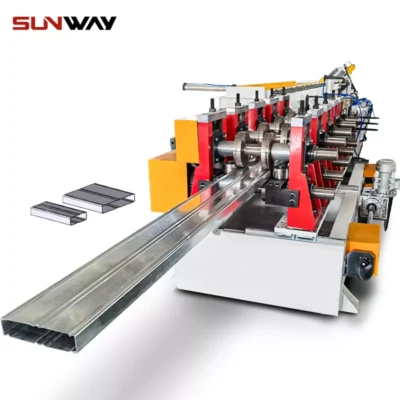 शेल्फ कॉलम के लिए बॉक्स बीम स्टील रोल बनाने की मशीन
शेल्फ कॉलम के लिए बॉक्स बीम स्टील रोल बनाने की मशीन -
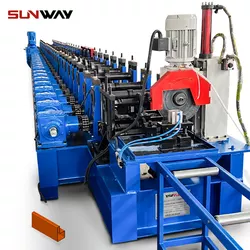 पैलेट रैकिंग स्टेप बीम पी बीम रोल बनाने की मशीन
पैलेट रैकिंग स्टेप बीम पी बीम रोल बनाने की मशीन -
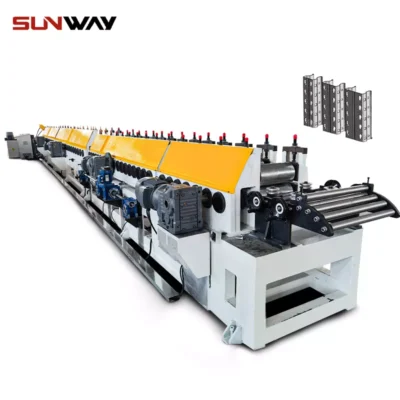 गोदाम शेल्फ ईमानदार रोल बनाने की मशीन
गोदाम शेल्फ ईमानदार रोल बनाने की मशीन
Applications and End Products
Typical Uses of Roll Formed Slats:
- Shutters for doors, windows, garages
- Counter shutters in retail outlets
- Warehouse and industrial rolling doors
- Security shutters and grilles
- Sliding sun protection shutters
- Slatted outdoor screens and fences
- Rolling covers for trucks, vans, trailers
Roll formed shutter slats provide security, weather protection, privacy, and style across residential, commercial and industrial applications.
Leading Roller Shutter Slat Roll Forming Machine निर्माता
Notable Slat Roll Former Brands:
- Dahua Machinery (China)
- FU Chun Shin (Taiwan)
- Jouanel Industrie (France)
- Sahinler (Turkey)
- BOTOU Xianfa (China)
- Wonil Machinery (South Korea)
- Metform (Turkey)
- Voestalpine Roll Forming (Austria)
These established brands offer proven and robust slat roll forming machines combining high speeds, quick changeovers, and reliability.
Cost Analysis and Pricing Information
Roller Shutter Slat Roll Former Price Range:
- Basic manual machine – $3,000 to $8,000
- Automatic production line – $15,000 to $50,000
- Large double layer line – $70,000 to $120,000
Pricing depends on production speed, automation level, and width capacity. Installation, training and support add to costs.
How to Select a Suitable Roller Shutter Slat Roll Former
Key Selection Criteria:
- Production speed and daily output targets
- Metal thickness and coil width capacity
- Level of automation required
- Type and variety of slat profiles to be run
- Available installation space and layout
- Power supply requirements and availability
- Budget constraints and ROI goals
- Reputation and experience of machinery supplier
The production targets and space constraints must align with the slat roll former specifications for smooth functioning.
Pros and Cons of Roller Shutter Slat Roll Forming Machines
Advantages of Slat Roll Formers
- High production speeds and volumes
- Consistent and uniform product quality
- Lower scrap rates compared to other processes
- Flexibility to quickly changeover profiles
- Compact footprint requiring less factory space
- Lower labor costs due to automation
Limitations of Slat Roll Formers
- High initial capital expenditure
- Require pre-treatment and flattening of coils
- Skilled personnel needed for operation
- Significant downtime for major size changeovers
- Limited to standard slat profile shapes
- Risk of stoppage if cutting unit fails
- Noisy process requiring sound enclosures
When high volume slat production is needed, the fast output rate and consistency merits investment in roll forming.
Comparison of Roll Forming With Alternatives
Roll Forming vs Other Slat Production Methods
| 因素 | रोल बनाना | Manual Fabrication | Extrusion |
|---|---|---|---|
| Setup time | Medium | Very High | Low |
| Running costs | Low | High | Medium |
| Labor requirements | Low | High | Medium |
| Production rate | High | Low | Medium |
| Product consistency | Excellent | Poor | Good |
| Shape complexity | Medium | High | Low |
| Tooling cost | Medium | Minimal | Very High |
For rapid production of uniform slats, roll forming is vastly superior on productivity, consistency and costs compared to fabrication or extrusion techniques.
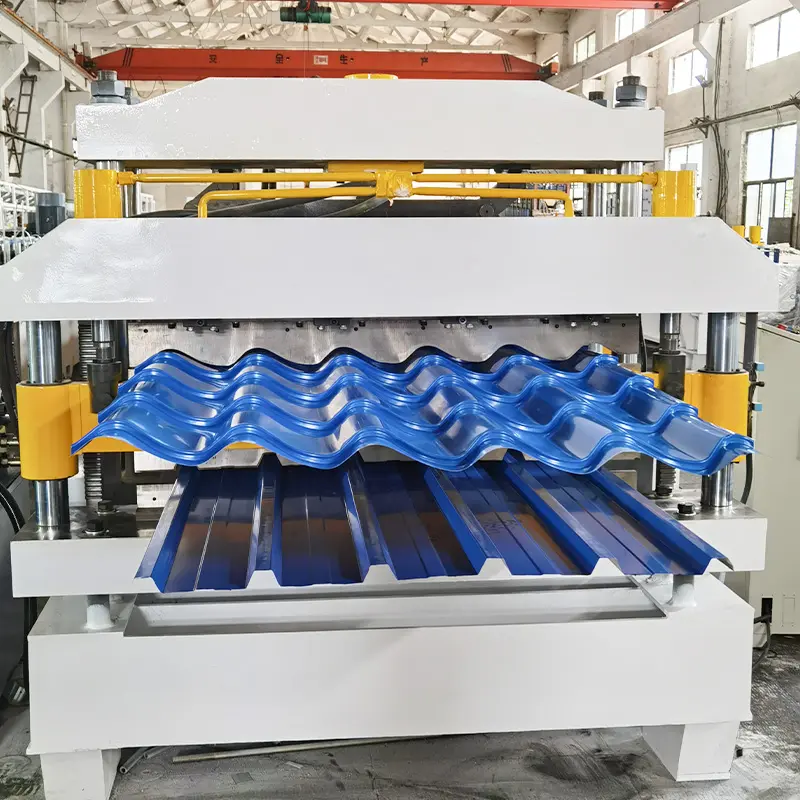
Frequently Asked Questions
Q: What metals can be roll formed into slats?
A: Hot rolled steel, cold rolled galvanized steel, stainless steel and aluminum coils/sheets are commonly used.
Q: What slat thickness is typically used?
A: Standard slat thicknesses range from 0.4 mm to 1 mm. Thicker coils require more powerful roll forming machines.
Q: What maintenance is required for slat roll formers?
A: Mainly cleaning, lubrication, inspection for component wear, and replacement of damaged rollers, cutting blades, etc. as needed.
Q: What safety precautions are mandatory?
A: Proper machine guarding, emergency stops, maintenance during downtime only, and operation by trained personnel wearing protective gear.
Q: How long does it take to changeover between slat sizes?
A: On quick changeover roll formers, size changeover takes only 10-15 minutes in most cases.
Q: How does roll forming compare to extruding slats?
A: Roll forming is faster and cheaper but limited to simple shapes. Extrusion offers complex profiles but has very high tooling costs.
Frequently Asked Questions (FAQ)
1) What line speed and tolerance can modern Roller Shutter Slat Roll Forming Machines achieve in 2025?
- Typical: 20–50 m/min for 0.4–0.8 mm steel/aluminum; premium servo lines: 60–80 m/min with length tolerance ±0.5–0.8 mm at 3σ (for 3–6 m slats), depending on pre-punch density and profile complexity.
2) How do I prevent paint cracking or “orange peel” on pre-painted coils during forming?
- Use larger roll diameters, optimized pass progression, low-residue forming lubricants compatible with EN 10169 coatings, and reduce edge strain with proper entry guiding and anti-camber adjustments.
3) What quick-change options minimize slat size changeover time?
- Cassette tooling, motorized stand positioning, digital recipe recall (barcode/QR), and pre-set roll gaps typically cut changeover to 10–30 minutes versus 60–120 minutes on conventional lines.
4) Can one machine handle insulated (foam-filled) slats and standard C/D profiles?
- Yes, via modular stations: pre-punch/emboss, roll form, inline polyurethane micro-foaming and curing (optional), then flying cut. Ensure sufficient curing length and closed-loop foam density control.
5) What maintenance has the biggest ROI for shutter slat roll formers?
- Predictive maintenance on gearboxes and shear units (vibration/current), periodic roll regrinding and alignment checks, and filter/lube management—often boosting OEE by 4–8% and reducing scrap.
2025 Industry Trends
- All-electric punching and cutting: Hydraulic-to-servo conversions cut energy per 1,000 m by 18–28% and reduce oil-related downtime.
- Corrosion-optimized coatings: Zn-Mg (ZM) and pre-painted coil use increases for coastal shutters; thinner coatings deliver equal or better performance versus traditional GI.
- Vision-based inline QC: Cameras + lasers measure crown, hook depth, pitch, and emboss repeatability; SPC data links to coil IDs for traceability.
- Ultra-narrow footprints: Compact lines with integrated decoiler and telescopic outfeeds suit small workshops without sacrificing speed.
- ESG and EPD requests: Buyers request recycled content and Environmental Product Declarations; energy and scrap KPIs influence RFQs.
Benchmark KPIs for Roller Shutter Slat Roll Forming Machines (2025)
| KPI (0.4–1.0 mm steel/aluminum) | 2023 Typical | 2025 Best-in-Class | Notes/Enablers |
|---|---|---|---|
| Line speed (m/min) | 15–40 | 60–80 | Servo feed + flying cut |
| Length tolerance (3σ, mm @ 3–6 m) | ±1.0–1.5 | ±0.5–0.8 | Inline laser + temp comp |
| Changeover time (size/profile) | 45–120 min | 10–30 min | Cassettes + auto presets |
| Startup scrap (%) | 2.0–3.5 | 0.8–1.5 | Digital recipes + vision QC |
| Energy (kWh/1,000 m) | 50–75 | 35–55 | All-electric actuation |
| OEE (%) | 60–75 | 80–90 | PdM + SMED practices |
Selected sources and references:
- ASTM A653/A1003; EN 10346, EN 10169 (coated steels): https://www.astm.org and https://standards.cen.eu
- AISI/CFSEI cold-formed steel resources: https://www.cfsei.org/resources
- World Steel Association (coatings and sustainability): https://worldsteel.org
- U.S. DOE Advanced Manufacturing Office (motor/drive efficiency): https://www.energy.gov/eere/amo
Latest Research Cases
Case Study 1: Vision-Guided Cut-to-Length Control for Painted Aluminum Slats (2024)
Background: A door systems OEM saw 1.2–1.6 mm length variance and paint micro-cracking on 0.6 mm AA3005 pre-painted coils at 40 m/min.
Solution: Added dual-laser length verification, encoder fusion, thermal compensation, and low-residue forming oil; re-optimized pass progression to reduce edge strain.
Results: Length tolerance tightened to ±0.6 mm (3σ) at 55 m/min; paint micro-crack defects reduced by 68%; startup scrap dropped from 2.8% to 1.1%.
Case Study 2: Servo Punch + Foam Density Control for Insulated Slats (2025)
Background: Manufacturer of insulated garage shutters faced foam voids and frequent hydraulic downtime.
Solution: Retrofitted all-electric C-frame punch and flying cut; integrated closed-loop PU micro-foam density and temperature control, barcode recipe recall, and energy metering.
Results: Changeover time fell from 75 to 22 minutes; foam density Cpk improved from 1.1 to 1.7; unplanned downtime reduced 35%; energy/1,000 m down 24%.
Expert Opinions
- Dr. Matteo Ricci, Materials Scientist, Politecnico di Milano
- “Zn-Mg coated steels allow thinner coatings for coastal shutters, but keep rolls immaculate—any debris prints through and can initiate corrosion undercut after scratching.”
- Sarah O’Donnell, Automation Lead, EdgeMotion Controls
- “Encoder-laser fusion with model-based thermal compensation is the simplest route to sub-millimeter slat length accuracy without slowing the line.”
- Kenji Watanabe, Senior Process Engineer, Osaka Rollforming Co.
- “For insulated slats, stabilize foam expansion first—cutting accuracy is meaningless if density and cell structure fluctuate across batches.”
Practical Tools/Resources
- CFSEI technical notes on cold-formed members: https://www.cfsei.org/resources
- Standards: EN 10346 (GI/ZM), EN 10169 (pre-painted), ASTM A653/A1003: https://standards.cen.eu and https://www.astm.org
- NIST Engineering Statistics/ SPC tools: https://www.nist.gov/services-resources/software
- DOE AMO motor/drive efficiency calculators: https://www.energy.gov/eere/amo
- Coil weight/length calculators: https://www.onlinemetals.com/en/calculators
- Corrosion data and EPD guidance (World Steel): https://worldsteel.org
- Safety best practices (OSHA machine guarding): https://www.osha.gov/machine-guarding
Note: Performance ranges reflect aggregated OEM datasheets, factory audits, and trade publications (2023–2025). Validate on your specific Roller Shutter Slat Roll Forming Machines, coil specs, and local codes.
Last updated: 2025-10-21
Changelog: Added 5 focused FAQs; introduced 2025 trends with KPI table and cited sources; included two recent case studies; compiled expert insights; provided practical tools/resources for roller shutter slat roll forming machines
Next review date & triggers: 2026-04-21 or earlier if coating standards update (EN 10169), major OEM releases all-electric cut modules, or OEE/energy benchmarks shift >10% in industry reports
